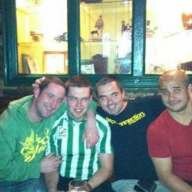 specials | 2015-05-03
specials | 2015-05-03
The Brazilians of FC Barcelona - Part One
The pioneers from Vasco and the legend Evaristo
Several different countries have provided world-class players for FC Barcelona. This is only to be expected, as the best talents would naturally want to play for the best club. But, especially since the 1990s, one country has stood out for bringing the biggest stars to ever defend our colors. In this article, we’ll talk about the glorious story of Brazilian players and FC Barcelona, the closest to a match made in football heaven if there ever was one.
Of all the nationalities to play for Barcelona in its 115-year history, England, with 51, has contributed the most. This considerable figure is mainly concentrated on the first 26 years of the club’s history, because, since 1925, only one Englishman has worn the Barcelona colors: Gary Lineker.
Brazil comes second in the ranks, having contributed 34 players. Only 26 of these 34 managed to play in official matches for the first team. The rest were members of the junior teams or else failed to impress while on trial. The most recent examples of Brazilians who never truly made it are Henrique and, especially, Keirrison, both of whom arrived with a big price tag but never managed to make a full first-team debut.
The pioneers from Vasco
The first Brazilians to land at FC Barcelona came from the same team: Vasco da Gama in Rio de Janeiro. The midfielder Fausto dos Santos, nicknamed “The Black Wonder”, and the goalkeeper Jaguaré Becerra, were so well-liked by culés during the Brazilian team’s tour of Spain that they were signed for the 1931-32 season, when they won the Copa Catalunya.
It wasn’t until 15 years after the two vascaínos played in the blaugrana colors that another Brazilian would join the culé side. Lucidio Batista da Silva, nicknamed “Bighead”, played on the right wing and defended the Barça shirt between 1947 and 1949.
The first and greatest Brazilian forward
Seven years later, the first Brazilian who would truly make history at FC Barcelona arrived: Evaristo de Macedo. The great Josep Samitier signed him from Club de Regatas Flamengo, where he had just won his third Rio de Janeiro state championship. He played for the blaugrana team for five seasons, scoring an impressive 178 goals in 226 games and, along with Ramallets, Kubala, and Suárez, in a team managed by Helenio Herrera, won three UEFA Cups (1958, 1959, and 1960), two Copas del Rey (1959 and 1962) and two La Ligas (1959 and 1960).
The highlight of his time at Barcelona came on November 23, 1960 when he scored a gol de peixinho[1], “a goal where the player slides on their stomach to head the ball into an empty net, rather than just tapping it in”. This goal sealed Real Madrid’s elimination from the European Cup for the first time. The merengues had been champions in the first five editions of the tournament before then.
Curiously, he never played another game for the Brazilian national team after his arrival in Barcelona. He had previously played just 14 games for the Seleção, scoring eight goals and, even today, still holds the record number of goals scored in a game for the Brazilian national team: Five. He later played with the Spanish national team that failed to qualify for the 1958 World Cup in Sweden. Thus, Evaristo was unable to play alongside Pelé who, at 17, would arrive on the world football scene in that very World Cup.
When the time came to renew his contract, the culé board told him they would only do so if he became a Spanish citizen. Evaristo refused and Real Madrid, victim of so many of the Brazilian’s goals, including a hat-trick in his first Clásico, took him. Evaristo explains how the fans, rather than becoming angry with him like what would happen several years later with Luis Figo, focused their anger on the board, accusing them of creating the atmosphere that would force his departure. Even to this day, Macedo still maintains that his best footballing years came at Barcelona and that those he spent at Madrid, including becoming a three-time winner of La Liga, were a “formality”.
Various knee injuries meant that he only played a few games in the white shirt, scoring just 15 goals. His only regret was not becoming a champion of Europe with Barça. The closest he got to achieving this feat was when Barça played against Benfica in what would come to be known as the “final of the posts” because of the number of times the ball hit the sticks.
As a result, Evaristo de Macedo went down in Spanish football history not only as the first Brazilian striker to play for FC Barcelona, but also as the first Brazilian to have played for both Barça and Real Madrid, where he was adored by both sets of fans.
Batuta, Marinho Péres, and Bío
After the Evaristo era had ended, quite a few Brazilians played for the team, among them the attacker Walter Silva Batuta (1966-67) and the fullback Marinho Peres (1974-76) who played regularly under Rinus Michels.
A curious fact about Marinho: In the 1974 World Cup, where Brazil were eliminated by Johan Cruyff’s orange machine, the Brazilian defender kicked Johan Neeskens and left him with a wound on his eyebrow. When he landed in Barcelona, Marinho was welcomed by the president and a player from the team: Neeskens. The Brazilian became a little nervous, but he soon calmed down when he saw his new teammate with a big smile and a fully-healed eyebrow.
Marinho had a good season (1975-76) playing under Rinus Michels, but following the legendary manager’s departure the next season and the arrival of Hennes Weisweiler who wanted to implement a system different from that of Cruyff and Neeskens, he had problems adapting. The end of his time at Barcelona was marked by the Franco regime which tried to force him to fulfill the obligatory military service since his parents were Spanish. For this reason, he returned to Brazil.
It’s worth highlighting Silvio “Bio” Modesto (1978-79) who, after impressing Michels and Cruyff while playing for Terrassa, was brought to Barcelona where he scored seven goals in 25 games. The most important of these goals was the one he scored in the penalty shootout against Anderlecht which sent the team through to the Recopa final where they would go on to beat Fortuna Düsseldorf. Bio died in 2008 having been homeless in Brazil for a number of years. He would, however, receive an allowance of €400 from Barça’s Association of Veterans every month until his death.
The dynamite that failed to explode on Catalan soil
In his second stint as Barcelona manager, Helenio Herrera made a huge mistake: not believing in the footballing ability of Carlos Roberto de Oliveira, known as “Roberto Dinamita” or “Dynamite”.
Dynamite was the hero of Vasco da Gama, where he won numerous Rio de Janeiro state titles and scoring no less than 290 goals for the team from Cruz de Malta between 1971 and 1979. Joaquim Rifé, who was having discrepancies with the team's striker at the time Hans Krankl, signed the player for the Catalan club. Dynamite scored two goals on his debut. He played 10 games in the blaugrana shirt and scored another three goals, taking his tally to five goals in 10 matches. The departure of Rifé and the arrival of a Herrera who didn’t believe in the player, combined with his genuine problems of adapting to Europe, caused Roberto Dynamite to lose his place in the starting lineup.
Obviously, Brazil’s best teams were following the crack. Even Flamengo, Vasco’s eternal rival, tried to sign him. Four months later, the Vasco fans got to see their hero again. Dynamite scored five goals against Corinthians, the dominant team from that era, in front of more than 110,000 spectators in the Maracaná stadium.
In the remaining months of 1980, after coming to Barcelona, suffering, and eventually leaving, he scored 36 goals in the Vasco shirt. He finished his career with an incredible 707 goals. He is the highest goalscorer in the history of the Brazilian championship, with 190 goals, and also the Rio state championship, with 279 goals. He set the record for goals scored in a single season in Brazilian football in 1981, just one year after his stay in Catalonia, when he scored 61 with the cruzmaltina shirt. This record however was beaten in 2000 by Romario, who scored 66 goals.
According to the International Federation of Football History & Statistics, Roberto Dynamite is the fifth highest goalscorer of all time, behind Pelé, Bican, Puskas, and Romario. If there ever was a Brazilian who wore the Barça colors and failed to live up to expectations, it was Roberto – the dynamite that never managed to explode.
Cleo Hickmann
Two years after the Roberto Dynamite disaster, Barça signed another Brazilian who wouldn’t even complete a full season at the club. After Schuster was injured by a horrific challenge from Goicoetxea, the German manager, Udo Lattek, requested a new midfielder from the club’s board. The arrival of the 22-year-old Cléo Inácio Hickmann soon followed.
The footballer, who came from Internacional in Porto Alegre, soon saw himself involved in a controversy: He gave an interview for a local magazine in which he allowed them to photograph him half-naked, which led to him being labelled a homosexual. As a result of this incident, beyond being the player Lattek wanted or not, Cléo was a controversial player.
The club’s board put pressure on Cléo to marry his girlfriend, so the rumors would cease. It was successful, but the player only managed to play in a friendly against Hospitalet. Cléo returned to Internacional, but he would get his own personal victory: A few months later, he would return to Barcelona and play against Diego Maradona’s Barça in the Argentinian’s presentation match in the Joan Gamper Trophy. Internacional won 3-1 and Cleó was able to prove that, even if he wasn’t great, he was still the kind of player who could have done a good job in the Catalan team’s midfield.
The Brazilians of FC Barcelona - Part Two
- [1] Literally “little fish”, it is so called since the player sliding along the grass resembles a fish swimming in the water. It is considered an insulting way to concede a goal.










